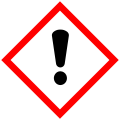Titan(IV)-fluorid
| Kristallstruktur | ||||||||||||||||
|---|---|---|---|---|---|---|---|---|---|---|---|---|---|---|---|---|
 | ||||||||||||||||
| _ Ti4+ _ F− Kristallstruktur mit Einheitszelle | ||||||||||||||||
| Kristallsystem | orthorhombisch | |||||||||||||||
| Raumgruppe | Pnma (Nr. 62) | |||||||||||||||
| Gitterparameter | a = 2281,1, b = 384,8, c = 956,8 pm, Z = 12[1] | |||||||||||||||
| Allgemeines | ||||||||||||||||
| Name | Titan(IV)-fluorid | |||||||||||||||
| Andere Namen | Titantetrafluorid | |||||||||||||||
| Verhältnisformel | TiF4 | |||||||||||||||
| Kurzbeschreibung | farbloser Feststoff[2] | |||||||||||||||
| Externe Identifikatoren/Datenbanken | ||||||||||||||||
| ||||||||||||||||
| Eigenschaften | ||||||||||||||||
| Molare Masse | 123,86 g·mol−1 | |||||||||||||||
| Aggregatzustand | fest[2] | |||||||||||||||
| Dichte | 2,798 g·cm−3 (25 °C)[3] | |||||||||||||||
| Schmelzpunkt | ||||||||||||||||
| Löslichkeit | ||||||||||||||||
| Sicherheitshinweise | ||||||||||||||||
| ||||||||||||||||
| Wenn nicht anders vermerkt, gelten die angegebenen Daten bei Standardbedingungen (0 °C, 1000 hPa). | ||||||||||||||||
Titan(IV)-fluorid ist eine anorganische chemische Verbindung des Titans aus der Gruppe der Fluoride.
Gewinnung und Darstellung
Titan(IV)-fluorid kann durch Reaktion von Titan(IV)-chlorid mit Fluorwasserstoff gewonnen werden.[2]
Eigenschaften
Titan(IV)-fluorid ist ein farbloses, lockeres, sehr hygroskopisches Pulver, das mit Wasser unter Zischen reagiert.[2]
Kristallstruktur
Titan(IV)-fluorid kristallisiert in einem eigenen, ungewöhnlichen Strukturtyp, in dem drei kristallographisch verschiedene Ti4+-Ionen vorliegen, die jeweils oktaedrisch von sechs F−-Ionen umgeben sind. Jeder der TiF6-Oktaeder ist über zwei cis-ständige, äquatoriale F−-Ionen mit je einem der beiden anderen TiF6-Oktaeder verbunden. Dadurch wird ein Ti3F15-Ring aus drei eckenverknüpften TiF6-Oktaedern gebildet. Zusätzlich ist jeder der TiF6-Oktaeder trans-ständig über die Fluoratome mit je zwei weiteren Oktaedern verknüpft. Dadurch entstehen charakteristisches Merkmal voneinander isolierte Säulen (Kolumnarstruktur). Titan(IV)-fluorid besitzt ein orthorhombisches Kristallsystem und die Raumgruppe Pnma (Raumgruppen-Nr. 62) mit den Gitterparametern a = 2281,1 pm, b = 384,8 pm und c = 956,8 pm.[1]
- Verzerrt oktaedrische TiF6-Einheit
- Ti3F15-Ring aus drei TiF6-Oktaedern
- Kolumnenstruktur
Verwendung
Titan(IV)-fluorid wird zur Synthese von Glycosylfluoriden, Fluorhydrinen und der Addition von Carbanionen zu Aldehyden und Iminen verwendet. Es dient auch als Katalysator für chemoselektive Synthesen und Entfernung von Schutzgruppen von geminalen Diacetaten von Aldehyden. Es wurde auch der Einsatz in Zahncreme untersucht.[4]
Einzelnachweise
- ↑ a b H. Bialowons, M. Müller, B. G. Müller: Titantetrafluorid - Eine überraschend einfache Kolumnarstruktur. In: Zeitschrift für anorganische und allgemeine Chemie. Band 621, 1995, S. 1227–1231, doi:10.1002/zaac.19956210720.
- ↑ a b c d e f g h Georg Brauer (Hrsg.), unter Mitarbeit von Marianne Baudler u. a.: Handbuch der Präparativen Anorganischen Chemie. 3., umgearbeitete Auflage. Band II, Ferdinand Enke, Stuttgart 1978, ISBN 3-432-87813-3, S. 1343.
- ↑ a b c Datenblatt Titanium(IV) fluoride bei Sigma-Aldrich, abgerufen am 21. April 2023 (PDF).
- ↑ N. Schlueter, C. Ganss, U. Mueller, J. Klimek: Effect of Titanium Tetrafluoride and Sodium Fluoride on Erosion Progression in Enamel and Dentine in vitro. In: Caries Research. Band 41, 2007, S. 141–145, doi:10.1159/000098048.
Auf dieser Seite verwendete Medien
Ball-and-stick model of the ring structure in the crystal structure of titanium tetrafluoride, TiF4.
The crystal structure consists of three, crystallographically different Ti4+ cations which are surrounded octahedrally by six F– ions each. Each TiF6 octahedron is connected to two other TiF6 octahedra equatorially, creating a ring with the composition Ti3F15. By connecting these rings axially with other rings, isolated columns are formed.
Structure determined by single-crystal X-ray diffraction reported in Z. Anorg. Allg. Chem. 1995, 621, 1227–1231 and is available as CSD entry 1639008 and ICSD entry 78737.
CAS® Registry Number: 7783-63-3
Colour code:
- Titanium, Ti: light grey
- Fluorine, F: light green
Ball-and-stick model of the column structure as part of the crystal structure of titanium tetrafluoride, TiF4.
The crystal structure consists of three, crystallographically different Ti4+ cations which are surrounded octahedrally by six F– ions each. Each TiF6 octahedron is connected to two other TiF6 octahedra equatorially, creating a ring with the composition Ti3F15. By connecting these rings axially with other rings, isolated columns are formed.
Structure determined by single-crystal X-ray diffraction reported in Z. Anorg. Allg. Chem. 1995, 621, 1227–1231 and is available as CSD entry 1639008 and ICSD entry 78737.
CAS® Registry Number: 7783-63-3
Colour code:
- Titanium, Ti: light grey
- Fluorine, F: light green
Globally Harmonized System of Classification and Labelling of Chemicals (GHS) pictogram for corrosive substances
Ball-and-stick model of the coordination geometry of Ti in the crystal structure of titanium tetrafluoride, TiF4.
The crystal structure consists of three, crystallographically different Ti4+ cations which are surrounded octahedrally by six F– ions each. Each TiF6 octahedron is connected to two other TiF6 octahedra equatorially, creating a ring with the composition Ti3F15. By connecting these rings axially with other rings, isolated columns are formed.
Structure determined by single-crystal X-ray diffraction reported in Z. Anorg. Allg. Chem. 1995, 621, 1227–1231 and is available as CSD entry 1639008 and ICSD entry 78737.
CAS® Registry Number: 7783-63-3
Colour code:
- Titanium, Ti: light grey
- Fluorine, F: light green
Ball-and-stick model of the unit cell as part of the crystal structure of titanium tetrafluoride, TiF4.
The crystal structure consists of three, crystallographically different Ti4+ cations which are surrounded octahedrally by six F– ions each. Each TiF6 octahedron is connected to two other TiF6 octahedra equatorially, creating a ring with the composition Ti3F15. By connecting these rings axially with other rings, isolated columns are formed.
Structure determined by single-crystal X-ray diffraction reported in Z. Anorg. Allg. Chem. 1995, 621, 1227–1231 and is available as CSD entry 1639008 and ICSD entry 78737.
CAS® Registry Number: 7783-63-3
Colour code:
- Titanium, Ti: light grey
- Fluorine, F: light green









